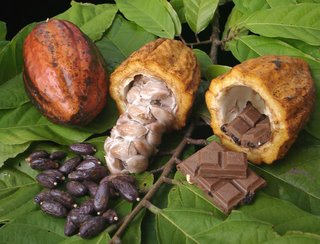 I'm sure many of us have often wondered how the cacao trees started to grow in the old homeland. We have somehow assumed that it is native to our place, because it is a tropical tree.
I'm sure many of us have often wondered how the cacao trees started to grow in the old homeland. We have somehow assumed that it is native to our place, because it is a tropical tree.But searches about its origins do not point to any Far East connections. Usual reports point to Latin American roots, specifically Aztec ones.
So, if not native to us, how did it get to the Philippines?
One possible explanation is contained in this little chronology:
* Chocolate was first noted in 1519 when Spanish explorer Hernando Cortez visited the court of Emperor Montezuma of Mexico. American historian William Hickling's History of the Conquest of Mexico (1838)reports that Montezuma "took no other beverage than the chocolatl, a potation of chocolate, flavored with vanilla and spices, and so prepared as to be reduced to a froth of the consistency of honey, which gradually dissolved in the mouth and was taken cold." The fact that Montezuma consumed his "chocolatl" in goblets before entering his harem led to the belief that it was an aphrodisiac.
* In 1528 Cortez brought chocolate back from Mexico to the royal court of King Charles V. Monks, hidden away in Spanish monasteries, processed the cocoa beans and kept chocolate a secret for nearly a century. It made a profitable industry for Spain, which planted cocoa trees in its overseas colonies.
If this is true, I suppose we have to give credit to Mother Spain for bringing it to our shores.
At present, cacao beans are almost as commonplace as coffee beans. And the cacao trees now form part as an important component in the intercropping farming methods used in many areas where coconut trees are also abundant. Many will find these cacao trees growing underneath rows of the taller coconut trees. And like coconut trees that can grow as high as 3000 feet, cacao trees adapt also to higher altitude.
Chocolate and cocoa drinks are now daily staple or food items for most countries in the world.
It serves us right to know where their basic ingredients come from.

Sir, may I use your photo of cacao and some data in my article "tropical Cooking with Travel Man: Home-made Sweet Cacao Bars in Bicol, Philippines"?
ReplyDeleteThank you in advance and God bless you!
Can't remember where I got the picture, but for me, it is okay to use.
ReplyDelete